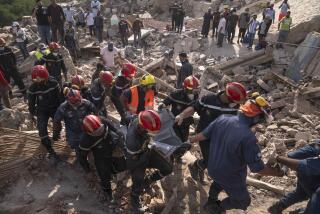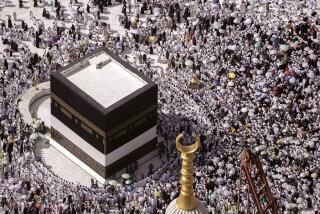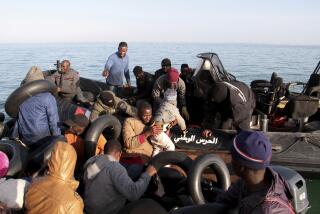This port city tones down its image but still hums with intrigue
- Share via
TANGIER, Morocco — Everything changed as soon as the ferry left Algeciras in Spain. The sound of Arabic--guttural and choppy--replaced the mellifluous Spanish we had heard during our weeks on the Iberian Peninsula. Suddenly, bare shoulders and knees--mine and my daughter’s--became objects of unwanted attention. The propriety of the Spaniards was replaced by an intensity that is wholly Moroccan.
And now we were almost in Tangier, ready to step off a ferry after a 2 1/2-hour early morning journey that would vault us into a place that is, as my 17-year-old daughter Becca described it, a cross between MTV and the Bible.
This two-day trip was a return visit for both of us. On my first trip 20 years ago, Tangier seemed dirtier and perhaps more dangerous, but in the two decades since, it has transformed itself into something less rough-and-tumble and more respectable but still exotic enough to have beckoned us again.
In this city of 600,000 souls, cultures are overlaid on cultures, creating an identity suffused with elements of each but resembling none of them precisely.
Geography and history explain the constant cross-pollination. Tangier sits strategically at the end of the Mediterranean Sea on the Strait of Gibraltar, helping make it an important port since ancient times. Phoenicians, then Carthaginians settled the city, but they were supplanted by the Romans in 82 BC. Next came the Vandals from Spain in AD 492, then the Arabs in 705, followed by centuries of struggles for dominance among the Spanish, Moroccans and Tunisians. The country pingponged between Portugal and Spain and fell under British rule by 1661. That lasted a little more than two decades, when Moroccans took control again.
So many world powers lusted for Tangier that it was declared an International Zone, controlled by France, Spain, Britain, Portugal, Sweden, Holland, Belgium, Italy and the U.S. Morocco won its own independence in 1956, and Tangier was reunited with the rest of the country.
This rich brew, coupled with laws that were notoriously lax, turned Tangier into a haven for the avant-garde. The list of those who have embraced it reads like a who’s who of playwrights and poets, musicians and artists and actors: Tennessee Williams, Allen Ginsberg, Paul Bowles, Jack Kerouac, the Rolling Stones, Elizabeth Taylor.
Now, as the ferry wheeled to dock in its port, we also hoped to be captivated by Tangier.
A honeycomb of ancient houses steps up the hill from the harbor to the crenelated walls of the casbah, the old Moorish fortress that perches over the harbor at the top of the city and is home to the 17th century palace of the sultans.
Beyond the minarets of several mosques, including the largest, Sidi Bou Abid, built in 1917, stands “the Mountain,” an enclave of palaces and villas that splatter daubs of color among the pine-swathed hills.
We were swept down the gangplank toward a throng of guides who awaited us, all dressed in full-length robes, or djellabas. The official guides wear brass nameplates to identify themselves as trained and licensed by the Moroccan government. Most are well versed in local culture and history and are necessary to help visitors find their way and fend off would-be vendors and suitors, imperative for women traveling alone. In a city where few people on the street speak English, guides are a must if only for the translation service. At $40 a day, a guide was a relatively inexpensive investment.
Becca, who demonstrates considerable street savvy for a 17-year-old, said, “I like the look of this one,” indicating a 30-ish man wearing a pale yellow djellaba who stood back a little from the others. His name was Hassan, and his confidence and quiet grace set him apart.
Hassan took charge, directing the taxi driver to the hotel where we had reservations. (If you arrive without reservations, you will end up at a hotel where your guide gets a commission. That is how the economy of Tangier works.) I had chosen the Hotel Dawliz for its location and was pleasantly surprised that the rooms were as welcoming as the hotel was convenient. It is on a high hill near the Grand Socco, the area from which all the important streets of the city emanate like the spokes of a wheel. It overlooks the medieval medina (the old quarter and the market and heart of Tangier) and is perched at the edge of the Ville Nouvelle, the section of the city built in the ‘20s.
At $80 a day, our room was clean and huge, with a large bathroom and a balcony offering sweeping views of the medina and beyond.
Hassan laid out our itinerary for that day. First he would direct the taxi to give us an overview of the city and its environs; then we would return to walk the medina. The taxi sped away from the Grand Socco, past the great Sidi Bou Abid mosque. Through the splendid arched doorway we glimpsed men bowing low over their prayer mats.
We passed the Spanish consulate, festooned with green, yellow and red flags. The Rue de la Plage sports some lovely Spanish townhouses. Nearby is the derelict Gran Teatro de Cervantes, built in 1913, whose glory as a house of performing arts has long since faded.
Going to another page of this cultural story, we next passed St. Andrew’s, a traditional stone 19th century English church, and right near the Petit Socco, nowadays a busy round plaza filled with cars and ringed with cafes and shops.
In Tangier’s freewheeling days, it was here that all the expatriates sat in the cafes and drank absinthe, a bitter liqueur that’s now illegal in most places. (It is said that at one time fully half of the population of Tangier was foreign.) Now the cafes are mainly full of hard-eyed Moroccan men drinking mint tea.
After this international section, the taxi climbed a few miles up into the higher reaches of the Mountain, where fabulous villas hide behind high walls smothered with bougainvillea. Novelist Paul Bowles lived nearby; the author of “The Sheltering Sky,” he died last month after living in Tangier for more than half a century. Our taxi continued past stands of fragrant umbrella pines, flowering white oleanders and mimosas, and half-mile-long enclaves of Saudi princes.
We stopped at a roadside stand where our orange juice was squeezed while we watched. To our right, the hillside fell off steeply; hundreds of feet below, the dark blue waters of the strait swirled. The breeze was delicious. In the summer, Tangier is invigorating, staying about 77 degrees, a refuge from the intense heat that bakes the rest of Morocco. Near Cape Spartel, which overlooks the Atlantic but is only a few miles from the medina, we stopped at the Hotel Mirage, a blend of Arabic and French influence. A three-mile-long beach with crystal clear breakers beckoned at the foot of a staircase down the cliffs.
Ten minutes later the taxi dropped us back at the Petit Socco. We plunged into the narrow maze of the medina, following Hassan, passing stacks of shining tomatoes next to a pile of goat heads. A man covered with brass cups that hung from his clothes sold drinks of water. Two men shouted at each other as they haggled over a bird in a cage. Behind them were 8-foot-high stacks of gleaming olives, ranging from pale yellow green to burgundy.
The sheer extent and variety of proffered items was almost bewildering: handcrafted silver teapots, beads, carved daggers, bird cages, hennaed leather lamps, ceramic platters, and rugs and more rugs. We had told Hassan we were not interested in buying, and he never pressed us. (Guides get a commission from the stores if you buy.) Our favorite store was the Coin de l’Art Berbere, a wonderful dusty antiques shop with old carved doors.
Late that afternoon, when Hassan went home, he arranged for another guide to take us up into the casbah, two minutes by taxi or a steep uphill walk from our hotel. Situated just inside the ramparts of the old Moorish fortress, the imposing palace, the Dar el-Makhzen, built in the 17th century by Moulay Ismail, now houses the Museum of Moroccan Arts and Antiquities. It is filled with exquisitely painted wooden ceilings, sculpted plasterwork, a rich mosaic of tiles, and artifacts from the nearby Roman ruins of Vorabulis. Just below this palace but inside the walls of the old fortress are several Arabian palaces bought by expatriates over the years.
Our guide knocked at a brass-studded wooden door, and we were led down a flight of stairs into a cave-like room with no windows but lined with brocade-covered benches. There a young woman painted lacy henna patterns onto Becca’s hands. The results did not fade for several weeks.
T he following day, Hassan arranged for the taxi to drive us to his hometown of Asilah, a charming beach town of 10,000 about 21 miles south of Tangier. Hassan greeted us warmly, shedding some of the formality of the first day. He was wearing a pure white djellaba, the color worn by devout men on Friday, the Muslim holy day. We wandered through the sun-filled maze of the old section, and visited Hassan II Cultural Center (named after the former king of Morocco), the fine contemporary art museum, which had a surprisingly sophisticated array of modern paintings.
Later, Hassan took us to his large, airy apartment, where he showed us his recent wedding pictures. His 19-year-old bride shyly served us mint tea. She stared intently at Becca until Hassan explained that he had told her about Becca’s tongue ring. The bride jumped at the sight of it but quickly called several relatives from the kitchen to see. They chatted and fussed over Becca, a welcome so warm that it made her feel like a cherished pet.
“My home is your home,” Hassan said. “Your daughter,” he added, “would be safe with me.”
I believed him, and with that expression of good intent, we were once more captivated by the charms of Tangier.
Lucretia Bingham is a freelance writer living in Old Lyme, Conn.
(BEGIN TEXT OF INFOBOX / INFOGRAPHIC)
GUIDEBOOK
The Road to Morocco
Getting there: You can get to Tangier by air from Madrid or London, but for a day trip, it is easier to get there by ferry, as we did. It’s only a 2 1/2-hour ferry ride from Algeciras, Spain. During the summer, the ferries go every hour; in the winter, they run several times a day. (Hydrofoils are faster but run less frequently.) The round-trip fare from Spain is about $50.
Where to stay: The Hotel Continental is in the middle of the medina, and its slightly tattered rooms can be overwhelming. But the price (from about $30 a night, double) and atmosphere are definitely right. Telephone 011-212-993-1024; fax 011-212-993-1143.
The four-star Hotel Dawliz has a stunning view and large spotless rooms, and it overlooks the medina. Prices start about $70 a night, double. Tel. 011-212-933-1812; fax 011-212-933-1823.
Hotel El Minzah is a world-class five-star hotel, but it’s often full. Doubles start about $200 a night. Tel. 011-212-993-5885; fax 011-212-993-4546. Or call (800) 448-8355.
Where to eat: You can get mint teas, banana milks and ice creams on the patio of the Hotel Dawliz. Watching the sunset from this perch is a must. Mint tea is about $2. Hotel El Minzah has several restaurants, from French to Moroccan. All are good if a bit formal. Dinner is about $35 for two. You’ll find several restaurants in the medina. Try the Restaurant Hamadi, local tel. 993-4514.
For more information: Moroccan National Tourist Office, 20 E. 46th St., Suite 1201, New York, NY 10017; tel. (212) 557-2520, fax (212) 949-8148, Internet https://www.tourism-in-morocco.com.
More to Read
Sign up for Essential California
The most important California stories and recommendations in your inbox every morning.
You may occasionally receive promotional content from the Los Angeles Times.













